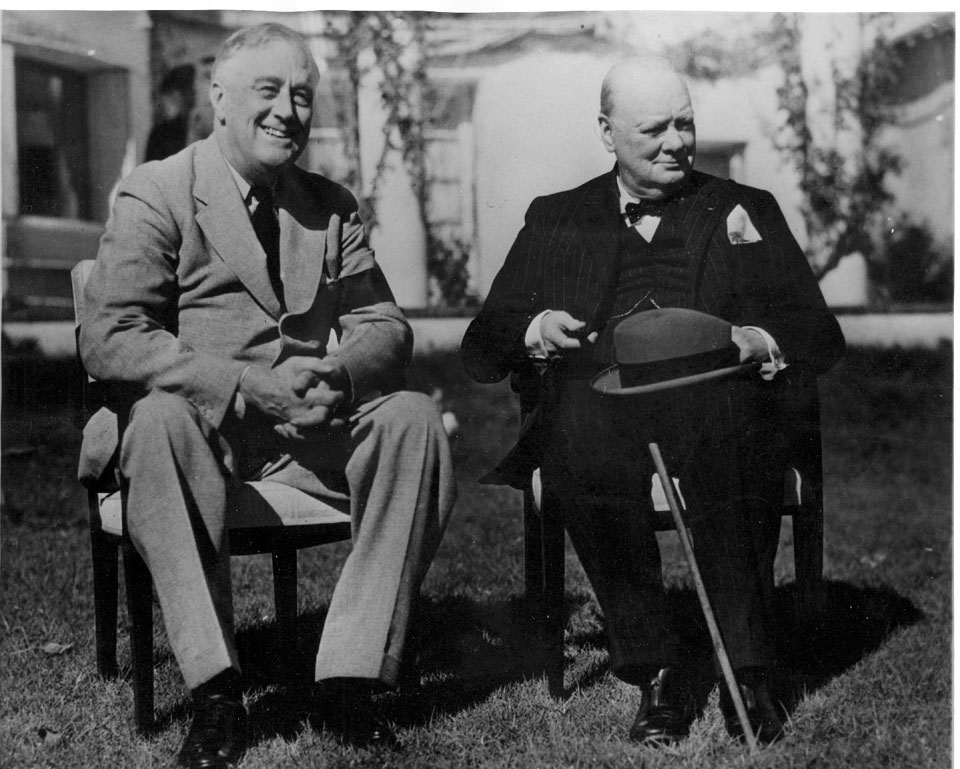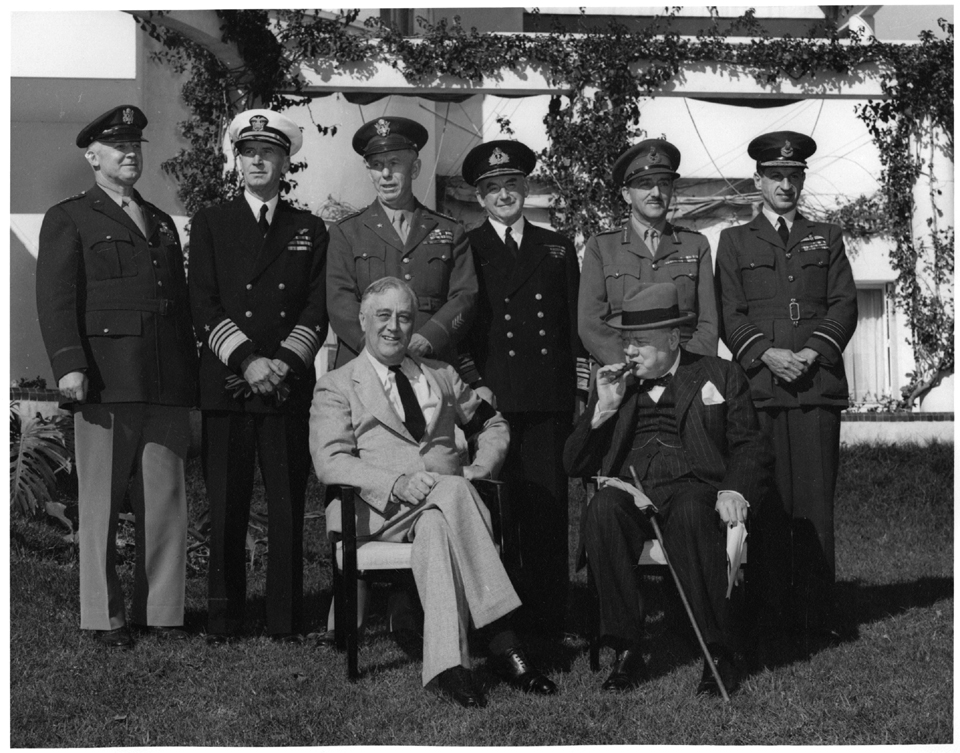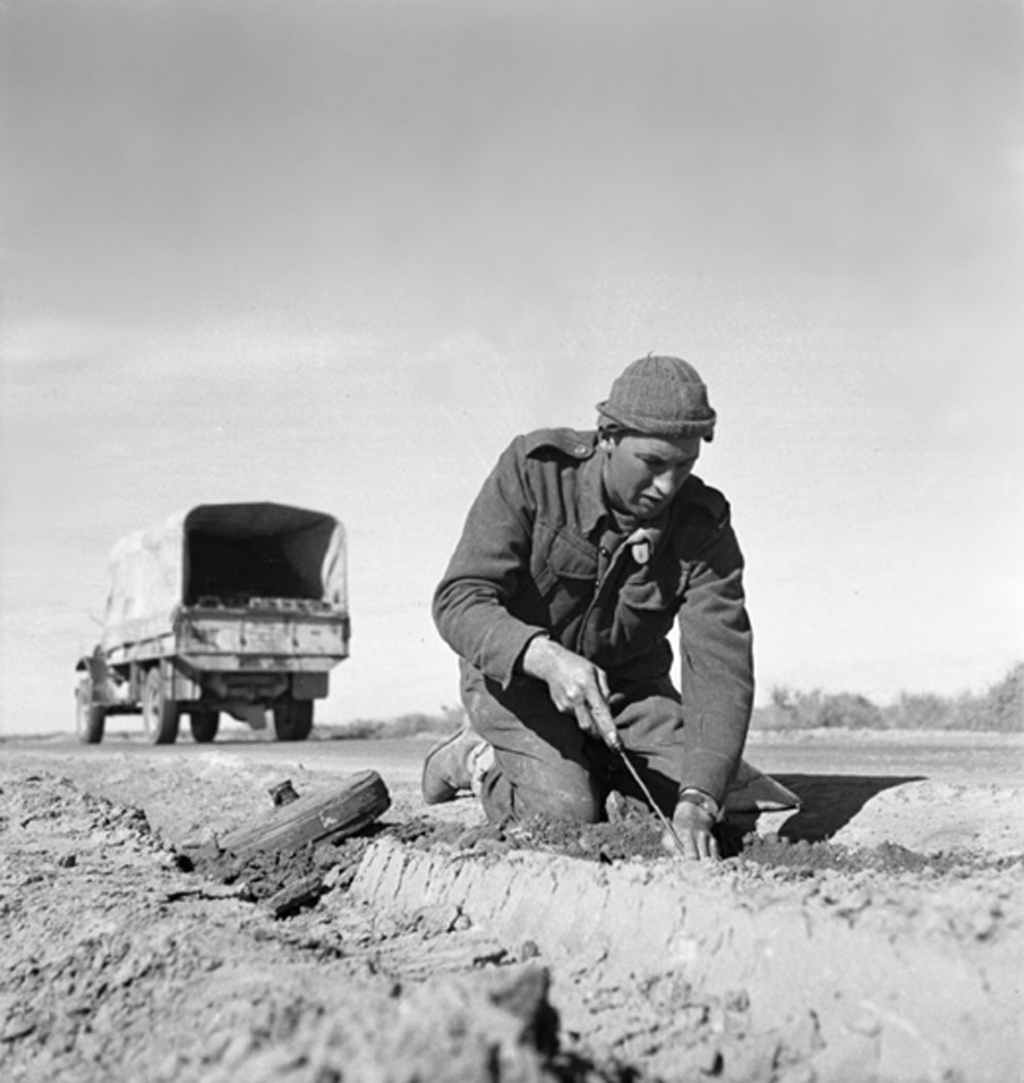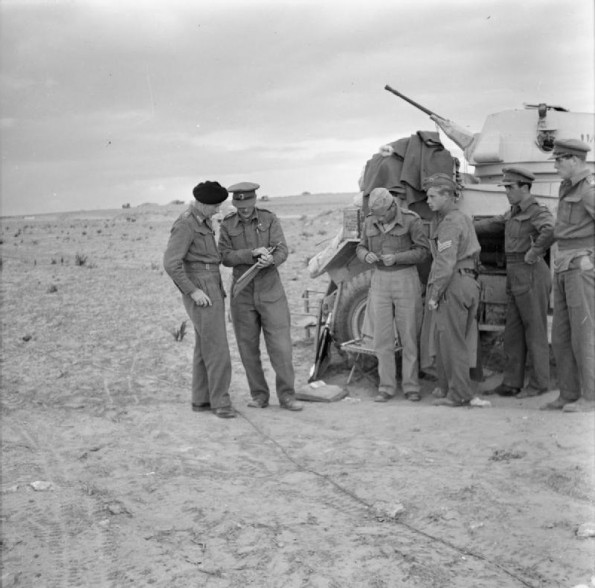Air Operations, Bismarcks
90th Heavy Bomb Group B-24s attack searchlight batteries and shipping at Rabaul.
[Air Operations, CBI
BURMA- 51st Fighter Group P-40s bomb and strafe Nsopzup.
Air Operations, East Indies
90th Heavy Bomb Group B-24s attack a ship off Amboina Island.
[Air Operations, Europe
BOMBER COMMANDDaylight Ops:
- 23 Bostons and 18 Venturas attack airfields in France. 12 Mitchells of Nos. 98 and 180 Squadrons attack oil targets at Terneuzen near Ghent. This is the first raid by this new type of aircraft.
- 2 Venturas and 3 Mitchells are lost in the day's operations.
- 2 Mosquitos attack Cologne for the first time using Oboe without a loss. 55 houses are damaged, 5 people are killed and 22 are injured. It is believed by this raid that a few aircraft using modern aids can inflict as much damage as 100 bombers did previously with marginal weather conditions.
Air Operations, Libya
- XII Bomber Command B-25s attack a road junction near Tipoli.
- 9th Air Force P-40s support the British 8th Army.
Air Operations, Mediterranean
- 6 XII Bomber Command severely damage an Axis freighter while on an anti-shipping sweep between Sicily and Tunisia.
- 14th Fighter Group P-38 pilots down 2 Ju-88s near the Egadi Islands at 1110 hours.
Air Operations, New Guinea
V Bomber Command B-25s attack Lae and 3d Light Bomb Group A-20s attack boats along the coast.
[Air Operations, Solomons
- XIII Bomber Command B-17s attack Rekata Bay.
- Throughout the night Japanese Navy bombers mount nuisance attacks against Guadalcanal.
|
|
Air Operations, Tunisia
- Two formations of XII Bomber Command B-17s attack Tunis/El Aouina Airdrome in the morning.
- XII Bomber Command B-26s attack Tunis/El Aouina Airdrome shortly after noon.
- XII Bomber Command B-25s attack Tunis/El Aouina Airdrome again during the afternoon.
- While helping Allied ground forces hold against a German Army counterattack in the Pont-du-Fahs area, the 81st Fighter Group makes its combat debut with an attack by 10 92nd Fighter Squadron P-39s against vehicles and gun postions. Also in support of ground actions are 16 33rd Fighter Group P-40s and P-40s of the USAAF-equipped Lafayette Escadrille, a Free French Air Force unit operating as part of the 12th Air Force. In addition to the fighter attacks, 47th Light Bomb Group A-20s attack a German Army tank depot near Ousseltia.
- 1 33rd Fighter Group P-40 is lost in ground support action; 2 1st Fighter Group P-38s and their pilots are lost to Luftwaffe fighters while attack German Army road columns in southern Tunisia
Eastern Front
A German communiqué admits for the first time that the Russians, attacking from the west, have considerably reduced the defensive perimeter of the 6th Army at Stalingrad. The Russian Voronezh Front, commanded by Gen Golikov and consisting of 3 armies, 1 armored army and 2 assault groups, launches the offensive against Voronezh, one of the 'hedgehogs' of the German line. The final phase of the Red Army assault on Stalingrad begins characteristically with a massive bombardment followed by infantry attacks. In the extreme south the Russians retake Salsk on the Stalingrad-Novorossiysk railway line. Salsk has been an important Luftwaffe base and a main German supply center for the Caucasus. The German hold on Rostov and the entire Caucasus is imperilled.
Red Army forces launch an offensive to retake Voronezh. Von Paulus radios Hitler from Stalingrad: 'Rations exhausted. Over 12,000 wounded unattended in the pocket.' Hitler responds: 'Surrender is out of the question.'
Russian Mortar Battery |
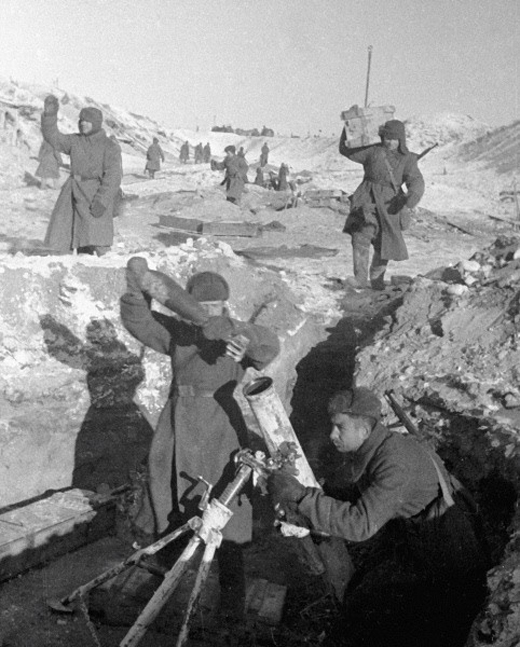 |
In the Caucasus, Salsk falls to the Russians.
SOUTHERN SECTORFollowing a rapid redeployment, the Don Front renews the offensive against Paulus' 6th Army. The attack opens with an overwhelming arty barrage the pulverizes the German line. Resistance is weaker that earlier in the month. Gumrak comes under intense fire as 21st Army approaches Stalingrad.
With his army on the verge of collapse, Paulus requests permission to open negotiations but is again ordered to fight to the last man.
Manstein pulls the 11th Panzer Division away from Hollidt to deal with the 2nd Guards Army threat at Manutchskaya.
[Guadalcanal
The XIV Corps opens its final offensive toward the Poha River at 0630. The assault troops are supported by artillery, air, and naval gunfire. The CAM Div pushes westward toward the heights southeast of Kokumbona (Hills 99 and 98) with elements of 3 regiments in the assault. The 6th Marines, advancaing along the coast, is stopped by enemy fire from a ravine west of Hill 94. The 147th Infantry in the center and the 182nd Infantry on the left are hampered more by terrain than by the enemy. The 147th Infantry seizes Hill 95. The 182nd Infantry makes contact with the 27th Infantry, 25th Div, north of Hill 88. On the corps southern flank, the 25th Div attacks toward Hill 87. The 1st Battalion, 27th Infantry, with the role of conducting a holding action while the 2nd Battalion, 161st Infantry, envelops the enemy's southern flank, moves forward toward Snake and quickly takes Hill 87, the day's objective, from which the enemy has withdrawn. Continuing its attack, it also seizes Hills 88 and 89 by 1035. To exploit this advantage, the divisional boundary is altered and the 27th Infantry is ordered to continue as rapidly as possible toward Kokumbona. Although short of rations and ammunition, the Japanese show great skill and courage in the defensive battle in the jungle. They halt the Marines on the coast while retiring in good order from some positions inland. By 1700, the 27th Infantry holds the heights just east and south of Kokumbona (Hills 90 and 98). The 2nd Battalion, 161st Infantry, the enveloping force, advances slowly through the jungle from Hill Y to Hill 87. The 2nd Battalion, 35th Infantry, assisted by a tank, forces a 200-yard gap in the northern part of the Gifu strongpoint. A final enemy counterattack is repelled during the night.[MORE]
[Mediterranean
Force K bombards Rommel's retreating forces east of Tripoli.
[New Guinea
The last Japanese are cleared from Papua by the Allied forces. The Allies have won their first victory over the Japanese on land during the war. The Australian 18th Brigade mops up the last centers of resistance on the coast west of Sanananda, while the American 163rd Infantry finally clears the Soputa-Sanananda road, mopping up the last defenders. It is estimated that the Japanese have deployed 12,000 to 16,000 men in the campaign and that they have lost about 7,000 killed; there are scarcely 350 prisoners, and most of these are Chinese or Koreans attached to the Japanese. Australian troops sustain approximately 5,700 casualties and US forces 2,788.
By clearing Papua, the Allies have eliminated the most pressing threat to Australia. The Battle of the Coral Sea ended an amphibious invasion attempt and now the overland challenge has been turned back as well. With Papua in Japanese hands, Australian would have been subjected to air and naval attack across a narrow span of water.
[North Africa
LIBYAPassing through the 51st Div, 8th Army, the 22nd Armored Bde coninues the coastal drive on Tripoli, reaching positions beyond Castelverde, while the southern column advances to within 17 miles of Tripoli. The retreating German forces begin pulling out of Tripoli evacuating large quantities of stores and destroying many of the port installations.
|
|
The Allied attack to clear the Ousseltia Valley is halted by strong opposition.
[Pacific
- The US submarine Tautog (SS-199) sinks the Japanese army cargo ship Yashima Maru 5 miles east of Salier Strait off the southern tip of Celebes.
- The US freighter Peter H. Burnett (7176t) is torpedoed by the Japanese submarine I-21 about 500 miles east o Newcastle, Australia and abandoned. There is only 1 casualty, an Armed Guard sailor died in the explosion.
